The Essential Denim Glossary
We won't waste your time listing terms like "buttons" or "coin pockets," but we will help shed some light on the terms denimheads love tossing around.
A buckle used to tighten the waistband on denim, before belts (and belt loops) were commonplace. A renewed interest in vintage styles have ushered in a resurgence of the the cinches on modern jeans.
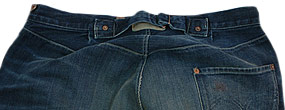
The physical process of making jeans look worn or faded by scraping, sanding and rubbing the surface—thus causing abrasion. Pumice stones are often used commercially.
A finishing technique that corrects denim's natural tendency to twist in the direction of the diagonal weave of the fabric. This occurs before sanforization.

Stitching sewn into stress points on jeans to reinforce places like zippers and pocket openings.
The diagonal weave of the twill cloth is intentionally interrupted to form a random design.
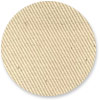
A heavyweight cloth weave, weighing in at 14oz./sq yard or more.
A term used to describe the underlying coloring of a cloth. Depending on the dyes and washing, indigo denim can have a black, brown, gray, green, red, or yellow caste to it.
One of the world's largest denim manufacturers, Cone Mills began producing denim in 1895 at their plant in Greensboro, North Carolina.
A item used to describe how the dark denim dye rubs off or bleeds onto skin or other fabrics.
A more environmentally conscious way of softening jeans. Organic proteins are used to speed up the chemical processes and eat away at the indigo. The finished jeans tend be stronger than those treated with with pumice stones and harsher chemicals.
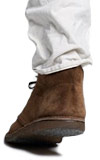
Dyeing a finished garment, instead of dyeing the yarn before it's woven.

The dye used to color denim, it was initially taken from the indigofera tinctoria plant, but was later synthesized in the early 20th century. Indigo continually fades because of its inability to penetrate fibers completely.
Fabric woven to the left. This is a more intricate process that produces a suppler product than right-hand twill.
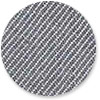
An industrial process to increase luster as well as keeping dye on the surface of the fabric so that dyes do not fully penetrate the fibre.
Denim that has not been rinsed or prewashed and thus is more rigid, stiff and durable than pre-aged or chemically softened jeans.
Woven on older looms, this denim is more rugged and is a less refined than modern jeans. This yarn adds character to the denim because of the tiny knots, or "slubs," running randomly throughout the yarn.

A small metal tab used to reinforce stress points. While it prevents the fabric from tearing, it's also used for non-functional ornamentation.
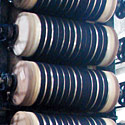
Thought to be the best way to dye yarn. Cotton threads are twisted into a rope and then dipped into an indigo bath several times—the more dips, the darker the yarn.
Originally called 'self-edge', the selvage is a slim woven band on either edge of the denim fabric. This prevents the edge of the denim from unravelling. Mills used various colors to distinguish manufactures. Vintage Levi's jeans had a single red stripe along both selvages,  Lee's was blue or green and Wrangler's was yellow.
Lee's was blue or green and Wrangler's was yellow.
© Copyright 2024 Valet Media LLC - All Rights Reserved. | Privacy Policy | Terms & Conditions
